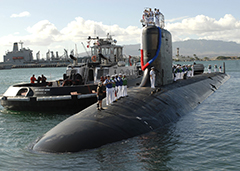1. Cold War Submarines:
During the Cold War, the U.S. Navy developed two different types of nuclear-powered submarines. The first was a sub that could launch nuclear missiles at other nations, called a Fleet Ballistic Missile Submarine, also known as an SSBN or "boomer". The other was an Attack Submarine, signified as SSN, or "fast attack." SSBNs are the larger of the two, up to around 560 feet (170 m) in length, while SSNs are built with speed and stealth in mind, and are around 360 feet (109 m) in length. Nuclear submarines served three primary roles during the Cold War: They performed strategic deterrence patrols, hunted other submarines and carried out special operations. More details
2. The Largest Submarine in World War II:
The Sen Toku I-400-class Imperial Japanese Navy submarines were the largest submarines of World War II and remained the largest ever built until the construction of nuclear ballistic missile submarines in the 1960s. They were submarine aircraft carriers able to carry three Aichi M6A Seiran aircraft underwater to their destinations. They were designed to surface, launch their planes, then quickly dive again before they were discovered. They also carried torpedoes for close-range combat. . They are considered the strategic predecessors to today’s ballistic submarines, especially to the Regulus missile program begun about a decade after World War II. More details
3. Type VII U-Boat:
Type VII U-boats were the most common type of German World War II U-boat. The Type VII was based on earlier German submarine designs going back to the World War I Type UB III and especially the cancelled Type UG, designed through the Dutch dummy company Ingenieurskantoor voor Scheepsbouw den Haag (I.v.S) which was set up by Germany after World War I in order to maintain and develop German submarine technology and to circumvent the limitations set by the Treaty of Versailles, and was built by shipyards around the world. More details
4. USS Nautilus Submarine:
USS Nautilus (SSN-571) was the world's first operational nuclear-powered submarine and the first submarine to complete a submerged transit of the North Pole on 3 August 1958. Sharing names with Captain Nemo's fictional submarine in Jules Verne's classic 1870 science fiction novel Twenty Thousand Leagues Under the Sea, and named after another USS Nautilus (SS-168) that served with distinction in World War II, the new atomic powered Nautilus was authorized in 1951, with laying down for construction in 1952 and launched in January 1954. Final construction was completed in 1955. More details
5. Russian Nuclear Submarines:
6. Nuclear Submarines:
A nuclear submarine is a submarine powered by a nuclear reactor. The performance advantages of nuclear submarines over "conventional" (typically diesel-electric) submarines are considerable: nuclear propulsion, being completely independent of air, frees the submarine from the need to surface frequently, as is necessary for conventional submarines; the large amount of power generated by a nuclear reactor allows nuclear submarines to operate at high speed for long periods of time; and the long interval between refuellings grants a range limited only by consumables such as food. More details
7. USS Texas Submarine:
USS Texas (SSN-775) is a Virginia-class submarine, and the fourth warship of the United States Navy to be named after the U.S. state of Texas. The contract to build her was awarded to the Northrop Grumman Newport News shipyard (then called Newport News Shipbuilding & Drydock Co.) in Newport News, Virginia on 30 September 1998 and her keel was laid down on 12 July 2002. She was christened on 31 July 2004 by Laura Bush, First Lady of the United States. She was launched into the James River on 9 April 2005. Under the command of Captain John Litherland, Texas arrived at Galveston Bay on 4 September 2006 and was escorted into the harbor by Elissa. More details
A nuclear submarine is a submarine powered by a nuclear reactor. The performance advantages of nuclear submarines over "conventional" (typically diesel-electric) submarines are considerable: nuclear propulsion, being completely independent of air, frees the submarine from the need to surface frequently, as is necessary for conventional submarines; the large amount of power generated by a nuclear reactor allows nuclear submarines to operate at high speed for long periods of time; and the long interval between refuellings grants a range limited only by consumables such as food. More details
6. Nuclear Submarines:
7. USS Texas Submarine:






